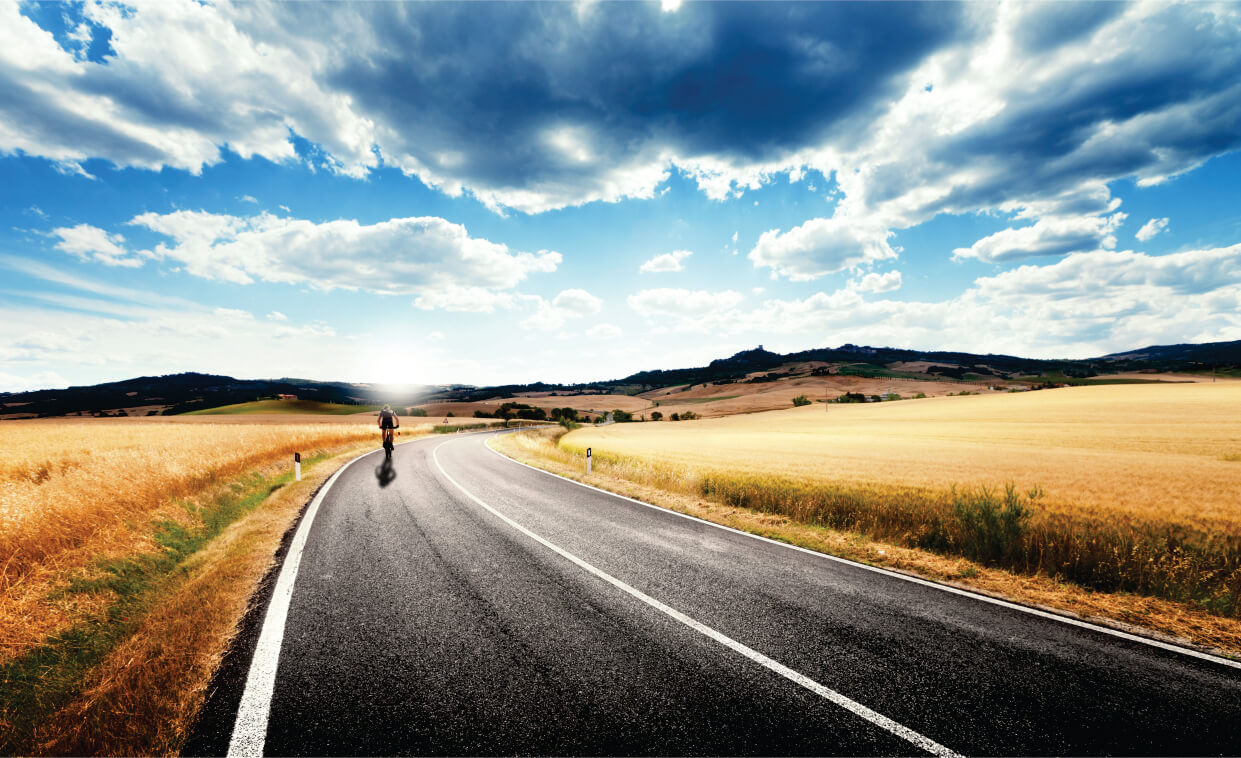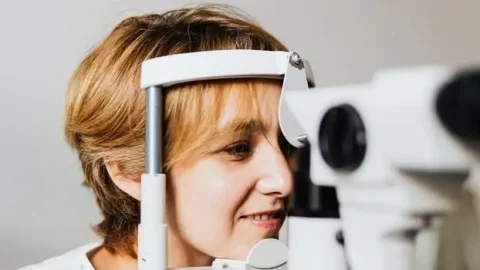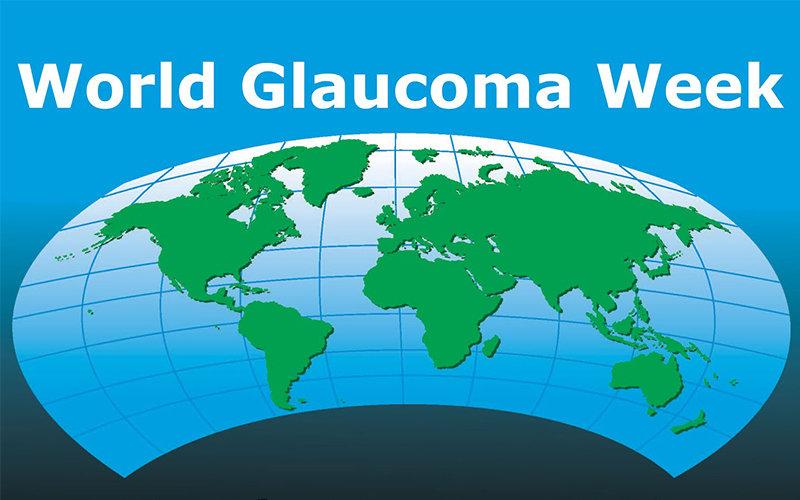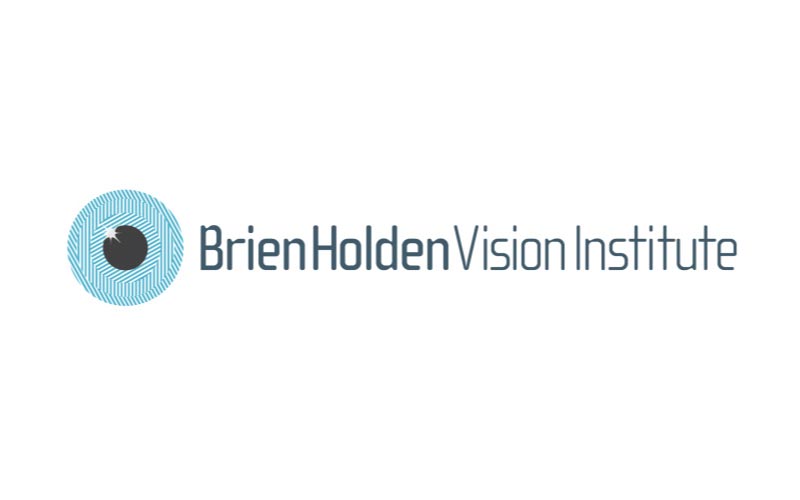by A S Carlson (FBDO, MPHIL)
Department of Optometry, University of Johannesburg
Light is non-ionizing electromagnetic radiation produced naturally by thermonuclear reactions in the sun and artificially by incandescence, for example, a candle flame or filaments from ordinary light bulbs. Electromagnetic radiation is characterized by its wavelength. The optical range of radiation extends from approximately 100 nm in the ultra-violet to approximately 106 nm in the infra-red. The radiation from the sun that reaches the earth’s atmosphere extends from approximately 280 nm in the ultra-violet to approximately 20000 nm in the infra-red. The visible part of the electromagnetic spectrum, the part that stimulates the photoreceptors in the retina and gives rise to a visual sensation lies between approximately 390 nm and 760 nm. The eye is not equally sensitive to all the wavelengths in this region of the spectrum. Figure 1 shows a spectral luminous efficiency against wavelength graph plotted for the human eye for a light source emitting radiation of eion) is approximately 555 nm (yellow-green), a minimum of approximately 690 nm (orange), and 430 nm. (Indigo). For scotopic vision, the maximum wavelength is 510 nm while the qual energy for wavelengths ranges between 380nm and 780 nm. It can be seen that the wavelength that evokes the maximum response for day vision (photopic visminimums are 640 and 395 nm respectively (see Figure 1).
In the majority of first world countries, artificial lighting has grown to the point of being accepted as normal, and sunlight as the unnatural lighting condition. The majority of us who work in towns and cities now spend most of our time, or the greater part thereof, working and living under artificial light, and less sunlight is observed. Figures show that in the UK alone, more than 10 million pairs of sunglasses are sold on an annual basis. In countries where the sunlight is much more intense, the figures are greater. In a person’s normal environment there is rarely any need to provide protection against ultra violet and infra- red radiations, but in a changed environment, the need may arise for protection against both visible and non-visible radiations. A North European who visits a tropical climate is almost certain to be deficient in protective pigmentation and would require protection against the more intense visible and heat radiations. Some fair skinned people are more sensitive to bright sunlight, where others would consider it to be normal. This may be intolerable especially when accompanied by ultra violet radiation reflected from snow, sea or sand in these fair skinned people. Generally, the need is rather to wear some form of protection against bright sunlight or glare as these are some of the causes of eyestrain.
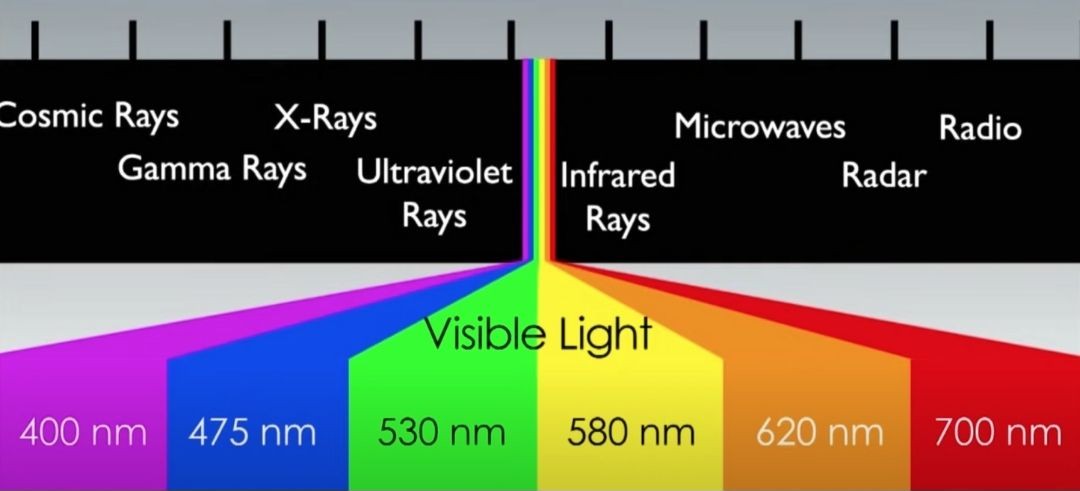
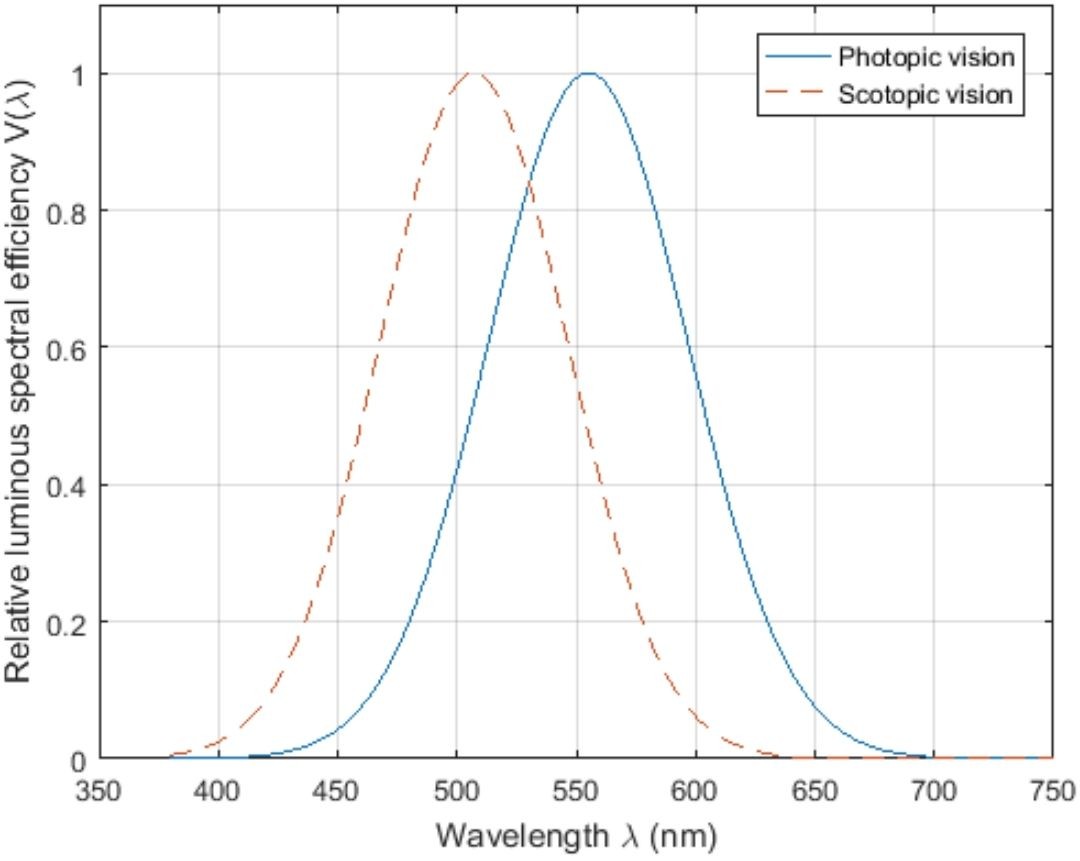
Figure 1. A spectral luminous efficiency against wavelength graph plotted for the human eye for a light source emitting radiation of equal energy for wavelengths ranging between 400nm and 750 nm for photopic vision (blue) and scotopic vision (red).
Eyestrain is a state of discomfort associated with undue actions of the intrinsic, extrinsic orbicularis, and frontalis muscles of the eye. The palpebral aperture is controlled by the orbicularis muscle. The frontalis muscle, responsible for ‘corrugating the brow’ contracts to a greater or lesser extent when the orbicularis contracts. Thus, eyestrain symptoms may present themselves as frontal, occipital, parietal, or temporal headaches, or any combination of these. Besides asthenopia, bright sunlight and glare are also causes of this. The ocular symptoms of eyestrain are bloodshot eyes, red lid margins, watering of the eyes, tiredness or sandy-gritty sensation, aching eyes, increased blink rate, and blepharospasm.
It must be strongly emphasized that these symptoms are not exclusively caused by eyestrain, and other causes must be eliminated such as those associated with refraction and pathology. In the case of the working environment, to prevent unwanted glare, the light source or the work position at the bench or desk should be changed. If none of these remedies is possible, tinted spectacles may be a last resort. In the case of driving, participating in, or watching any water sports or even for general wear, polarized lenses will offer the best solution to reduce glare.
Glare and Eyestrain
Tinted lenses have practical industrial applications for hazardous occupations such as welding, but they are mainly used for sunglass purposes, and much of their use in this context is cosmetic. Glare may be defined as any brightness within the visible spectrum which produces visual discomfort. Glare results from too high illumination, either overall or localised. The excessive light results in an excessive breakdown in the photosensitive pigments in the retinal receptors (cones) with a consequent reduction in the eye’s ability to discriminate object detail. That is, the eye’s sensitivity (acuity) is reduced. It is not difficult to realise that glare is a cause of reduced working efficiency.
You cannot judge a pair of sunglasses by their colour, at least not for eye protection purposes. Tints and shades of sunglasses do not reflect UV (ultraviolet) blocking ability. When sunglasses are made, the lenses are treated with UV-absorbing properties to be able to block UV light. Because these properties are usually colourless, clear lenses could block UVR just as well as dark-coloured lenses.
A tinted lens is defined as a lens that has a noticeable colour in transmission. Lenses may be of fixed colour, dyed or photochromic. Such lenses may be bought or supplied by a practitioner for cosmetic or fashion purposes, for reduction of unwanted harmful radiation, or for the modification of the incident radiation profile for various practical reasons (see Figure 2). An ideal sunglass should reduce UVR, reduce the transmission of visible light to a comfortable level without distorting colour values and maintain good vision across the spectrum. Grey lenses have an even transmission of all the wavelengths throughout the visible spectrum, presenting no colour distortion. Polaroid sunglasses have an added advantage over the normal filters in that they reduce more of the glare from reflected surfaces. They are also available both brown and grey tints. Mostly, the public seek advice and are looking for sunglasses for general or specific purposes that have maximum protection and safety features. In the case of lenses supplied for cosmetic purposes, the practitioner must be aware of the performance of the tint and be in a position to advise the patient, customer or client when necessary, on any problems that may occur, such as distortion of colours where colour coded signals (traffic lights) are used.
Purpose of Tints
Tints filter light in different ways, and some tints do a better job at blocking light than others. Some tints actually enhance colours, while others distort them. Tints have the ability to enhance vision in certain situations. Although you may admire a certain tint colour, it may not be the best one for your particular lifestyle. Grey is a popular neutral tint that allows the eyes to perceive colours in their purest form. Grey tints allow all wavelengths to pass through the lens equally. The greater the absorption properties, the darker the lens. Grey tints reduce brightness and attenuates glare (see Figure 3). Lenses that selectively absorb certain wavelengths and transmits others produce different coloured lenses (see Figure 4).
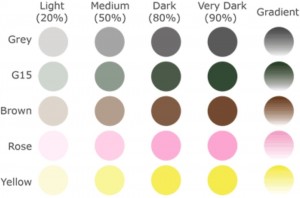
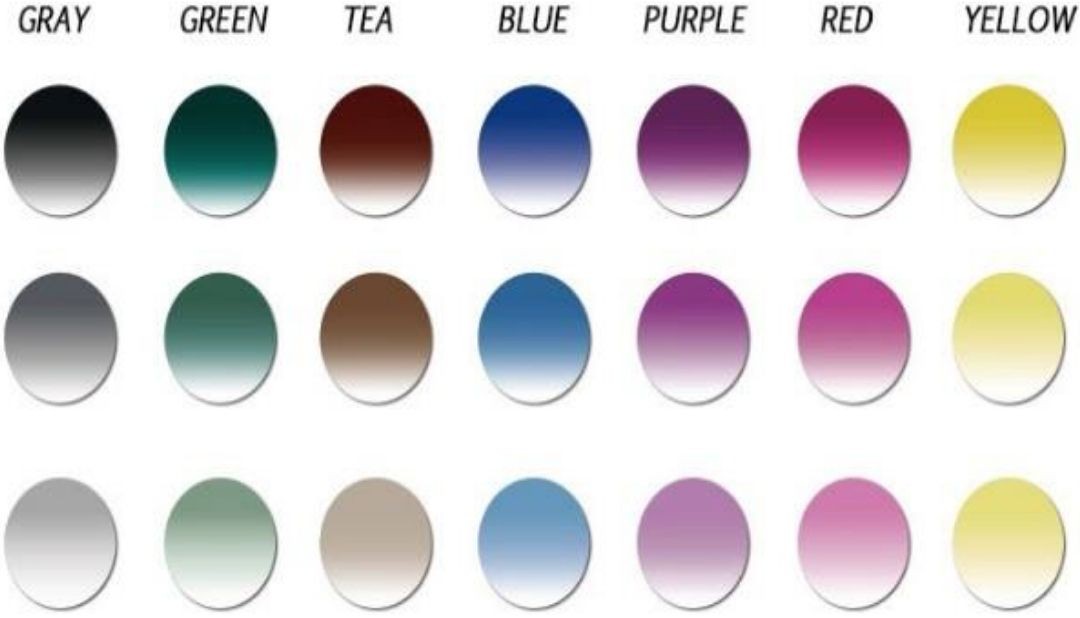
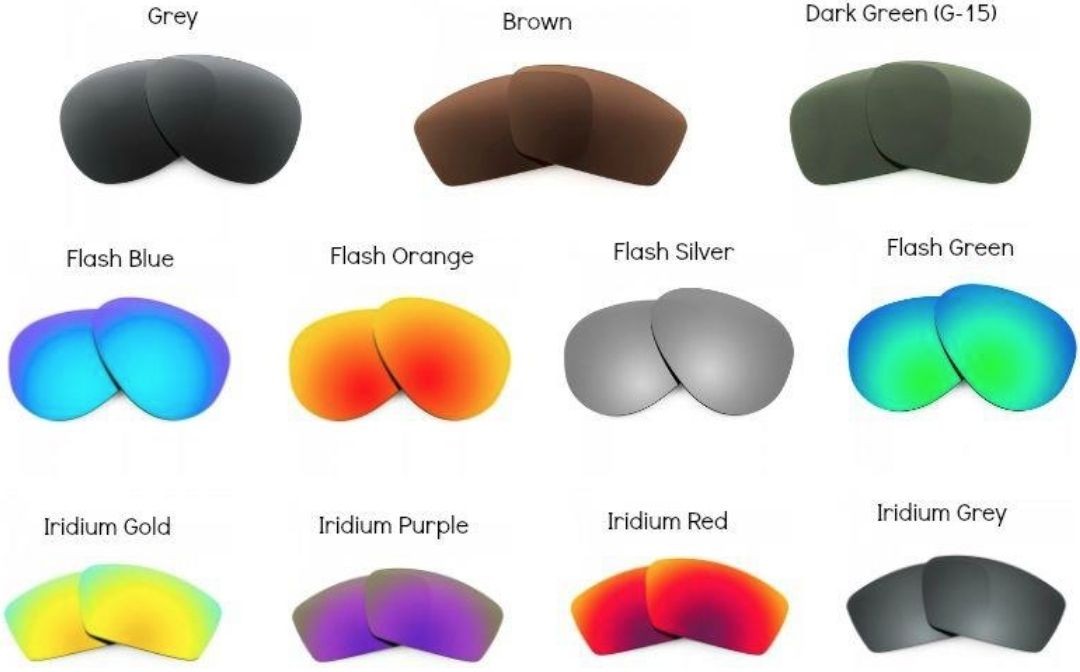
Figure 2. Variety of tints that are available. Full tints and gradient tints and reflective tints.
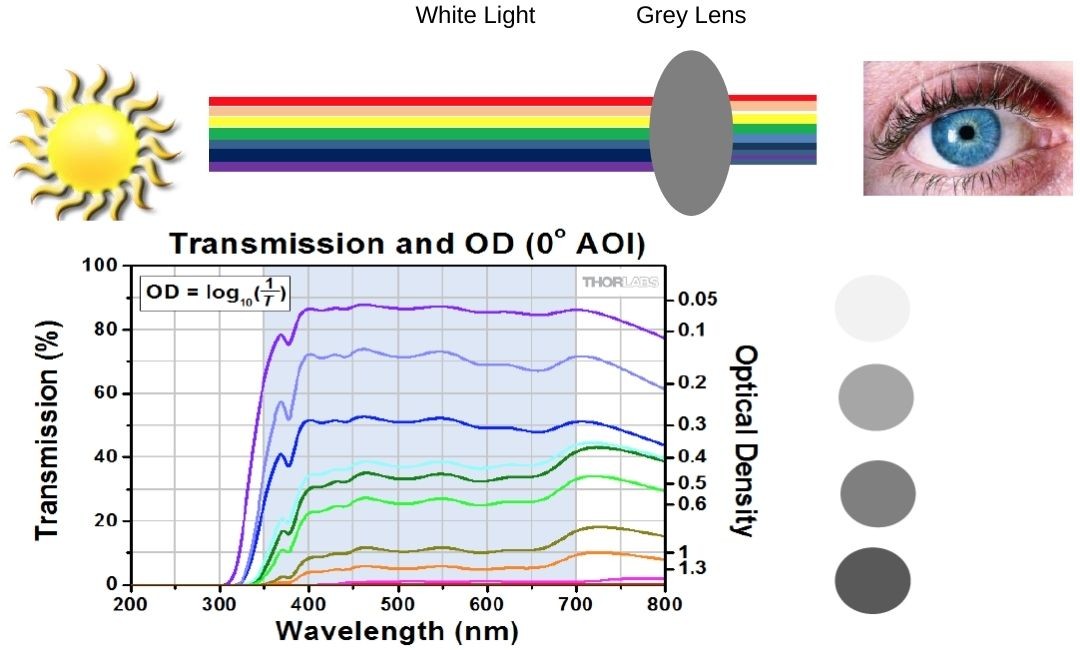
Figure 3. Transmission curve for grey lens (neutral density filter) for different densities.
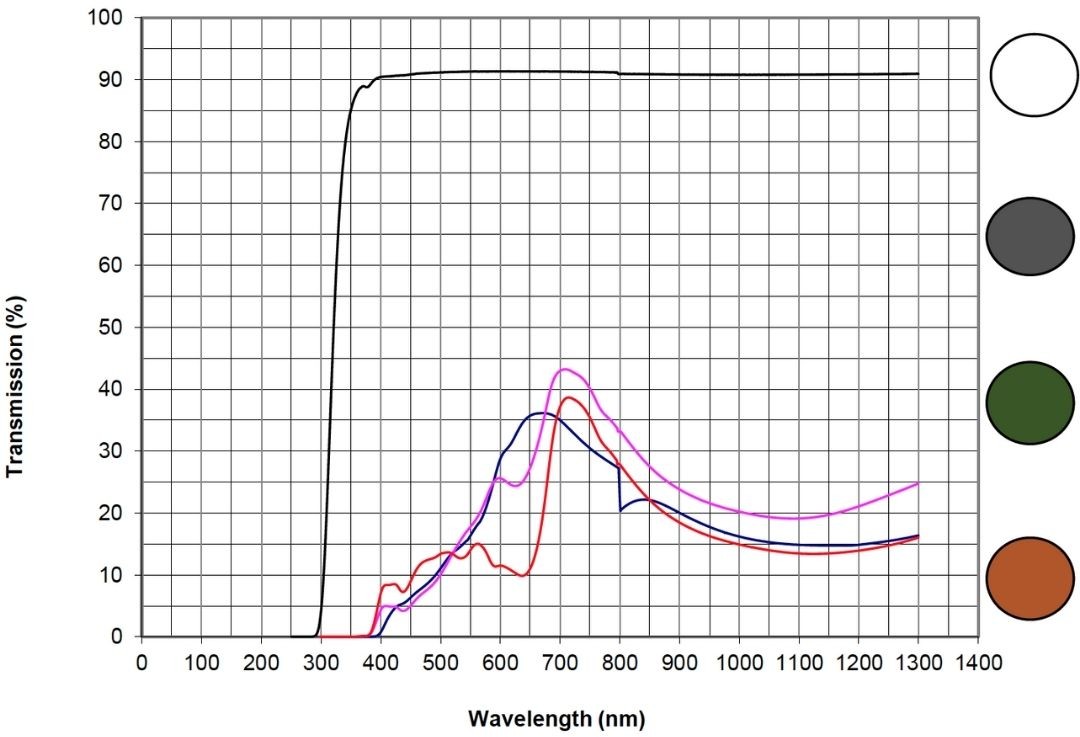
Figure 4. Transmission curves for Ray-Ban Brown Polarizers (Blue), G15 (Red) Brown B15 (Magenta), and clear white glass (Black)
Filter lenses filters out the disturbing or unwanted wavelengths at the same time allowing most of the useful light into the eye. They are usually used for specific purposes either for therapeutic, occupational, sporting or functional reasons. A few examples are shown below.
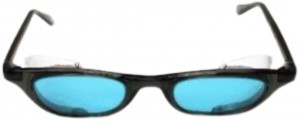
Didymium Filter
Didymium glass is a high luminous transmittance filter specifically designed to absorb yellow sodium light (589 nm) which occurs when heating glass. The lenses protect the eyes from certain visible and UV light produced in the glassblowing process. The filter enables the glassblower to see the glass while it is being worked in the flame. The filter is bluish pinkish in colour. A transmission curve is shown in Figure 5.
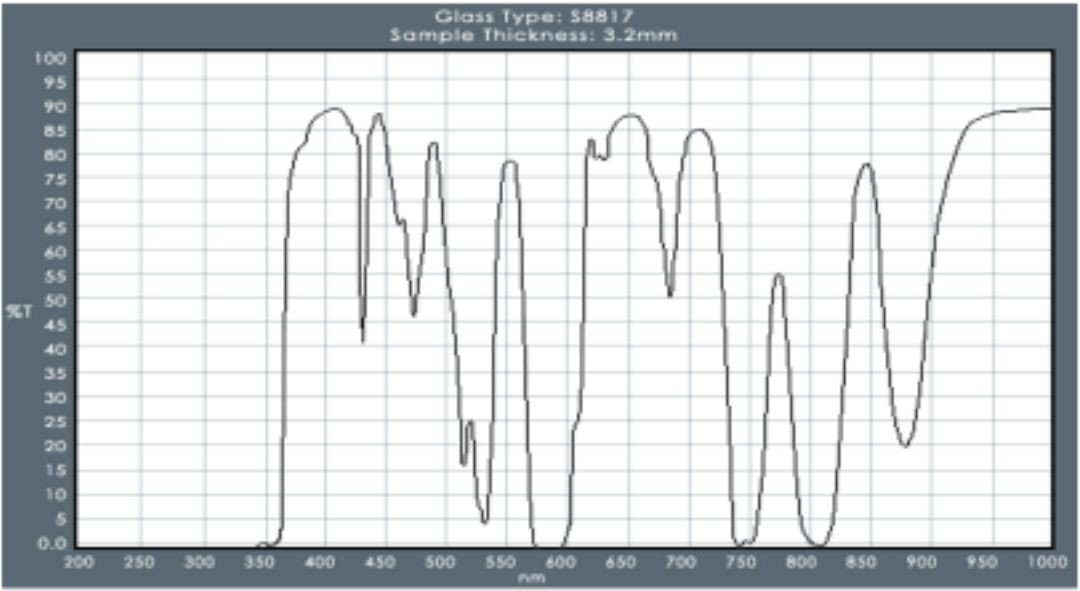
Figure 5. Transmission curve for a Didymium filter.
Filters used for Clay-pigeon shooting are purplish (red-blue) in colour. The clay pigeon is terracotta/orange in colour. The red enhances the colour of the orange clay making visibility easier while the blue attenuates the colourful background like trees. The filter is shown in Figure 6.
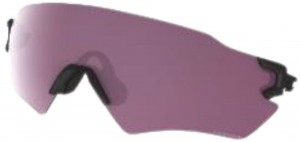
Figure 6. Purplish tint used for clay pigeon shooting.
Filters that cut out light at the blue end of the visible spectrum increases contrast and eases the eye’s ability to distinguish between light and dark areas. Such colours are brown, yellow and red. These filters, however, do cause colour distortion depending on percentage of light absorption. Yellow and brown filters are often recommended for subjects who have glaucoma, retinitis pigmentosa, cataracts and macular degeneration due to reduced contrast sensitivity caused by these conditions. Although these filters do not improve their colour vision, it improves contrast between the various shades of grey. Studies have shown that these filters also reduce their light sensitivity. Red filters may be cosmetic appealing to subjects with normal colour vision, however, they do cause colour distortion.
Blue light blockers
It is well documented that reducing the transmittance of blue light increases contrast and eases the eye’s ability to distinguish between light and dark areas. Such filters vary in colour from yellow to orange to red. As a minimum, a contrast filter should be expected to absorb all radiation below about 450 nm and rise to a peak transmission of about 525 nm and remain constant. The use of contrast filters reduces the flickering of fluorescent lighting in offices. Fluorescent filters have peak transmittance in the UV and blue regions of the spectrum and it is claimed that when these peaks of flickering are removed the flickering is less noticeable.
Using more powerful filters absorbs more of the blue light and increases contrast even more. This is possible because blue light scatters more than other wavelengths, causing a slightly blurry image on the retina. In cases where patients have had cataract surgery and the crystalline lens has been replaced with an intraocular lens, it is an extra reason why one should protect the eye from the harmful UV and blue light. It has been suggested that excessive blue light and UVR that penetrate the eye can be harmful to the retina, The crystalline lens has better protection against UV light than an artificial lens. Yellow filter lenses that absorb blue light up to 450, 511, or 527 nanometres are very useful for persons who have had cataract surgery as these filters do block out these wavelengths. Filter lenses are often combined with a polarized layer to reduce the total amount of light that is transmitted into the eye. Filters combined with polarizers are also a cosmetically attractive combination, hard to tell from normal sunglasses but with better visual quality. Visually impaired people have the greatest advantage from using filter lenses but in some situations, all people can experience enhanced contrast from blue-blocking filters. The following lenses are all blue-blocking filters and have all shown to increase contrast sensitivity;
 Brown sunglasses |
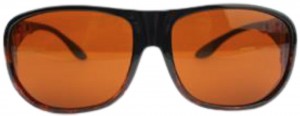 Amber filter |
Amber/Brown – Amber and brown tints reduce glare and block blue light, brightening vision on cloudy days and increasing contrast and visual acuity, especially against green and blue backgrounds such as grass and sky. Recommended for fishing, baseball, golf, hunting, cycling, and water sports.
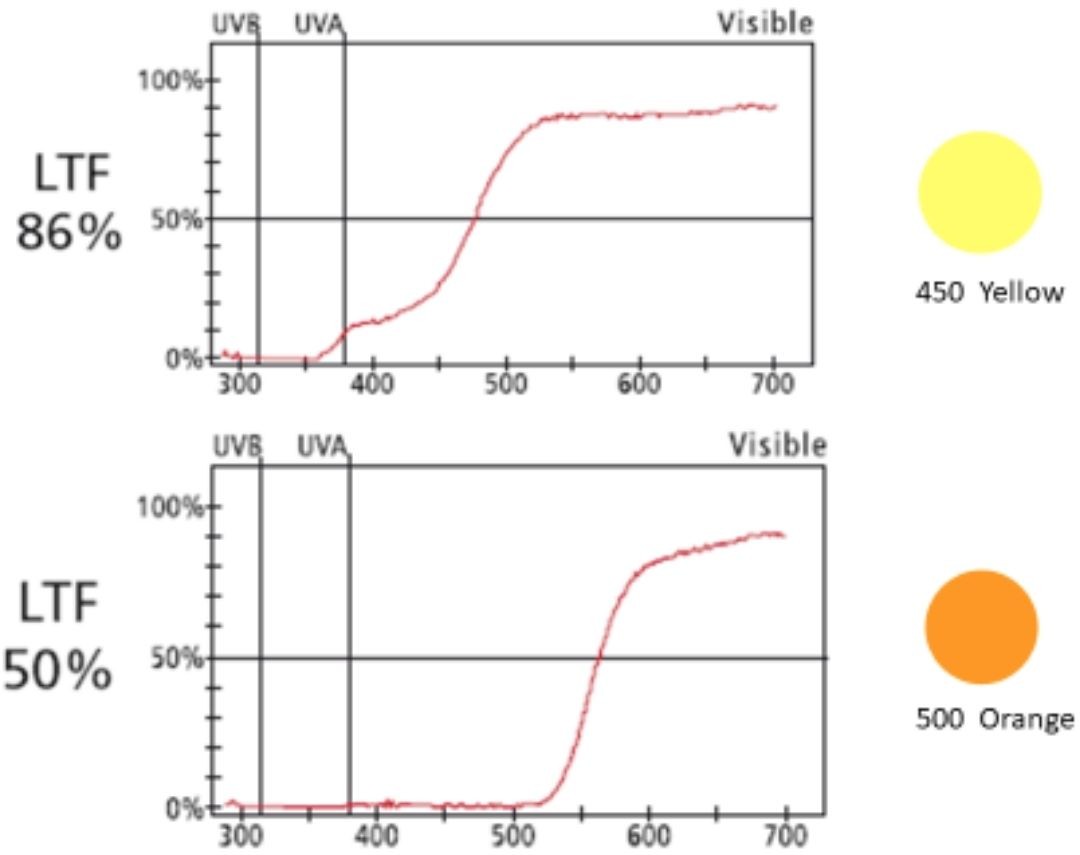
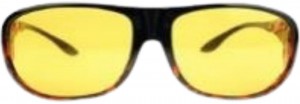 Yellow filter |
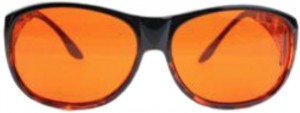 Orange filter |
Yellow/Orange – Recommended for snow activities and indoor ball sports Yellow and orange tints increase contrast in hazy, foggy, or low-light conditions. These tints tend to make objects appear sharper both indoors and outdoors, but can also cause colour distortion. Recommended for snow activities and indoor ball sports.
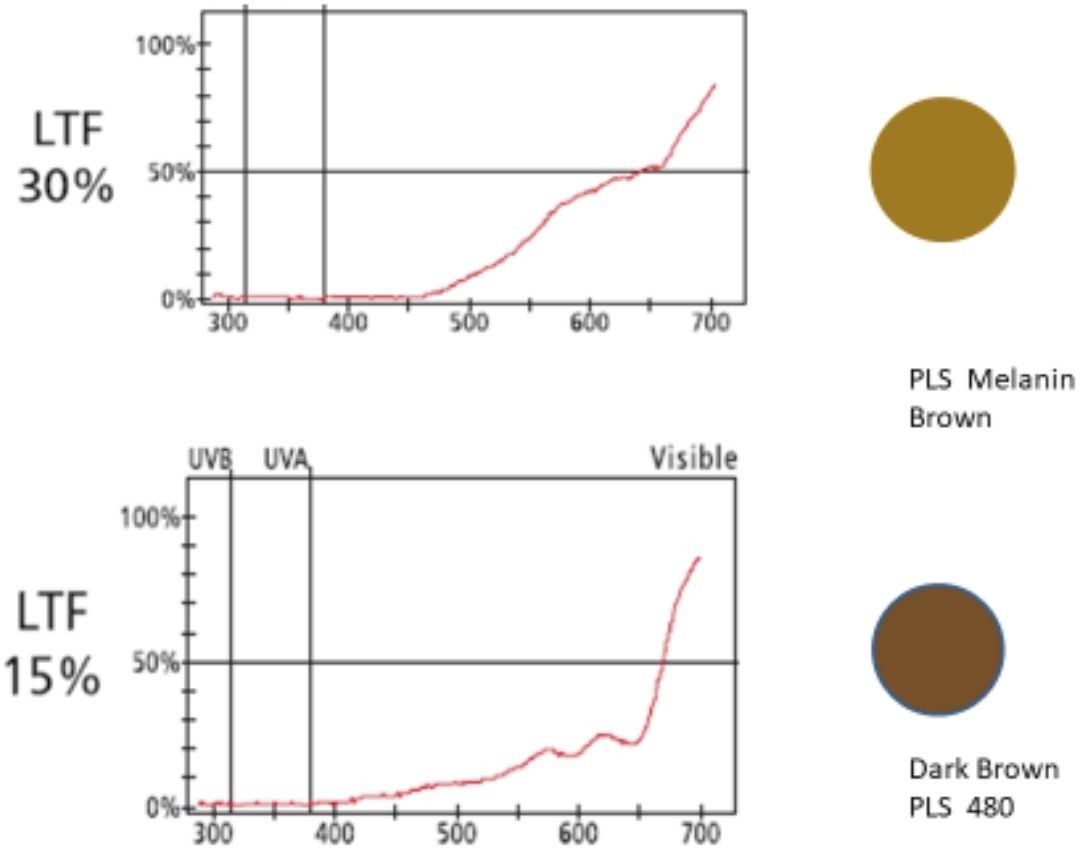
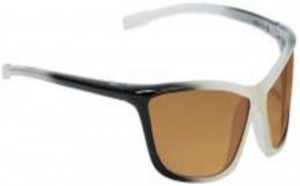 Melanin filter |
 Dark brown filter |
Melanin – Melanin pigment in sunglass tints is said to protect the eyes from aging changes related to sun exposure. Melanin tints, as well as brown lenses, are suitable for people with cataracts as they also reduce light scatter from the blue light and increase contrast.
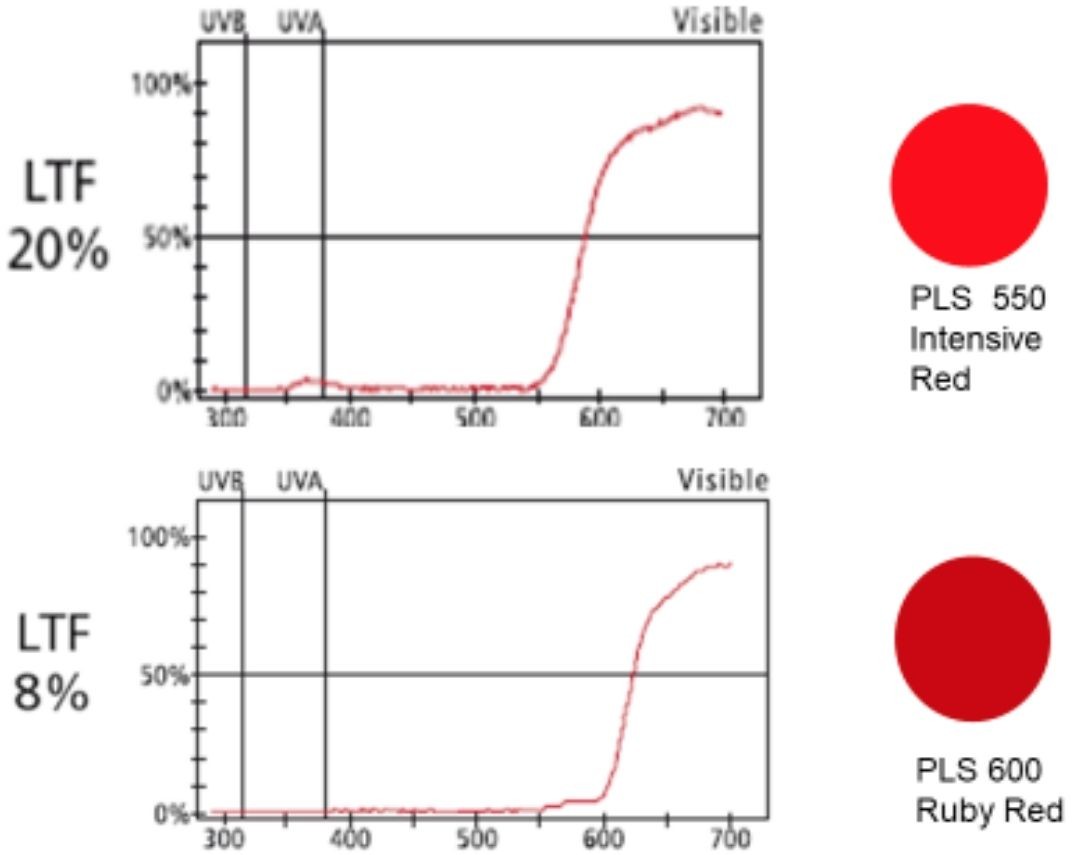
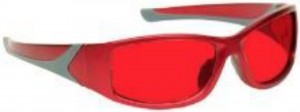 Intensive red filter |
 Ruby red filter |
Intensive and Ruby Red – These tints also increase contrast by blocking blue light. They have a reputation of being soothing to the eyes and more comfortable than others for longer wear-times. They also help with visibility while driving.
Coloured contrast filters are also prescribed for low vision patients that have retinal abnormalities.
Achromatopsia
Means without colour and is defined as cone cells having little or no function. It is a recessive, inherited condition. No cones or non-functioning cones cells are also known as Rod Monochromatism. Classification may include complete achromatopsia and incomplete achromatopsia.
Complete achromatopsia
Where there is no function of the cone cells, (see Figure 7) people are only able to perceive black, white, and shades of grey and have no real understanding of the concept of colour. A colour like red may be perceived as dark grey while yellow may be perceived as a light grey. The vision is much like that of a black and white photograph with varying shades of grey. Red or plum filters and/or red contact lenses are usually prescribed. Red light stimulates the rods and permits the eye to dark-adapt more quickly. See Figures 8 and 9.

Figure 7. OCT image of macule area showing no cones or non-functioning cones cells, also known as Rod Monochromatism.
Incomplete Achromatopsia
There is a profound colour impairment, but do have a small residual amount of colour vision. The visual acuity is slightly better due to the presence of some functioning cone cells in the retina.

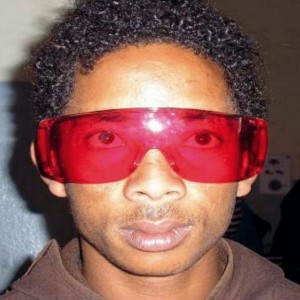 Figure 8. Red contacts lenses or visors prescribed for patients with achromatopsia.
Figure 8. Red contacts lenses or visors prescribed for patients with achromatopsia.
This is evident as red lights are installed into submarines. If a submarine is about to surface at night, red lights in the submarine are switched on before surfacing. This enables to eye to dark adapt before surfacing thus allowing better night vision once surfaced.

Figure 9. Red lights in a submarine stimulate the rods thus enabling the eye to dark adapt before surfacing at night.
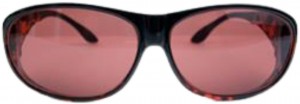
Plum coloured filter
Blue cone monochromat (BCM)
There is a failure of the red (L-cones) and green (M-cones) cones owing to a failure of the specific photopigments to form. Thus, BCM are left with only rods and the blue (S-cones) cones (see Figure 10). Blue cone monochromats is the rarer form of achromatopsia and nearly exclusively in males. Blue cone monochromatism is also known as X-linked Incomplete.
The BCM individual has only the blue cones and rods available to function in bright light. Blue cones, however, account for only 2% of the total cones in the retina. Thus 98% of the total cones are not functioning. can still be overwhelmed by in bright light, thus reducing their vision. They often squint constantly in bright light.
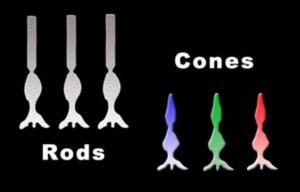
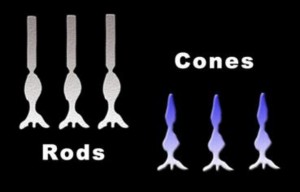
Figure 10. Normal retina and a blue cone monochromat (BCM).
Suggested filters
Red filters block the blue light and would thus cause a loss of vision. Blue light is a very high energy light and can bleach out the rod photo-pigments. Red light reduces the energy reaching the rods thus allowing them to function at higher levels than normal. Blue light can activate the remaining blue cones in the retina aiding the patient’s vision. The answer is to combine both blue and red dyes into a magenta filter, See Figure 11. Figure 12 shows the colour perception of a BCM compared to a person with normal colour vision.
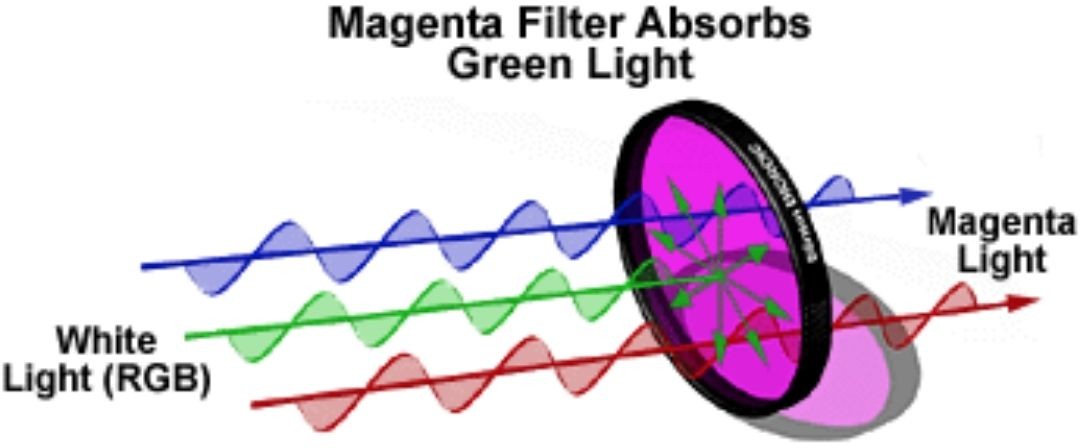
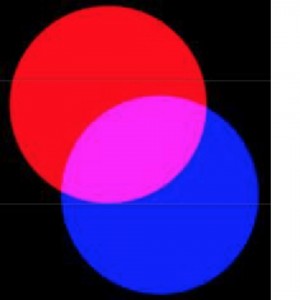
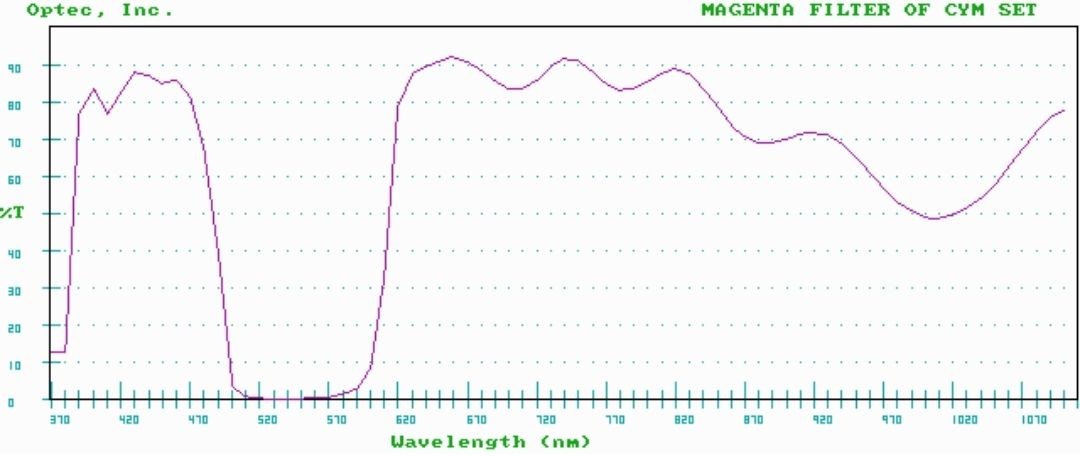
Figure 11. Magenta filter and transmission curve showing the wavelength transmission through the filter.
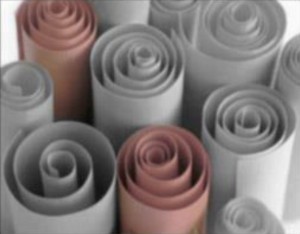
Blue cone monochromat
 Normal colour vision
Normal colour vision
Figure 12. Colour perception of a BCM compared to a person with normal colour vision
More common examples of contrast filters and their uses
Cataracts

People with cataracts suffer blurred distance vision, especially outdoors. Headlights and stoplights appear to have streaks or halos. They also suffer discomfort and veiling glare sensitivity and decreased contrast sensitivity due to blue light scattering inside the cataract. Reading ability is impaired because print appears faded and lacks contrast. Colour distinction is impaired, blues appear green and yellow appears white.
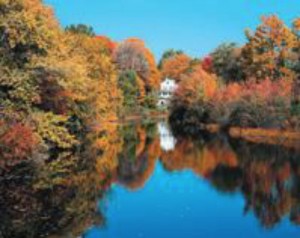
Normal vision

With cataract
Suggested filters will be blue light blockers such as yellow, amber, melanin brown and orange filters.
 Yellow |
 Amber |
 Melanin |
 Orange |
Macular degeneration (ARMD)

The effects of macular degeneration are central scotoma(s), decreased contrast sensitivity, blurred vision, discomforting glare and dazzling glare sensitivity. Suggested filters are blue light blockers that include red amber yellow and orange.
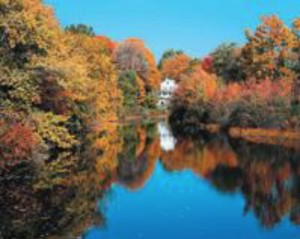
Normal vision

Macula degeneration
 Red |
 Amber |
 Yellow |
 Orange |
The filters recommended for visual impaired patients do not increase visual acuity, however, increases contrast. The choice of colour is also very subjective. Yellow filter glasses, often sold as “antifog” or “safety” glasses at department stores and other retail outlets, are claimed to improve contrast sensitivity and the yield of visually perceived objects, particularly under poor conditions (e.g., fog, rain and twilight), by enhancing contrast. The use of yellow filter glasses may safely be recommended to patients who report subjective improvement in contrast vision with such glasses.
References
- G Rieger. Improvement of contrast sensitivity with yellow filter glasses Can J Ophthalmol 1992 Apr;27(3):137-8.
- Jalie M. Ophthalmic Lenses and Dispensing. 3rd Butterworth Heinemann. Toronto 2008.
- Sun Giannos SA, Kraft ER, Lyons LJ, Gupta PK. Spectral evaluation of eyeglass blocking efficiency of ultraviolet/high-energy visible blue light for ocular protection. Optom Vis Sci. 2019;96(7):513-522. doi:10.1097/OPX.0000000000001393
- Gil S, Le bigot L. Seeing life through positive-tinted glasses: colour-meaning associations. PLoS ONE. 2014; 9(8):e104291. doi:10.1371/journal.pone.0104291 glass Coatings and Treatments


